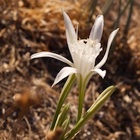Pancratium maritimum
Sea daffodil, sea lily Κρίνος της θάλασσας

Amaryllidaceae - amaryllis family Monocot.
Pancratium maritimum
Sea daffodil, sea lily Κρίνος της θάλασσας

Amaryllidaceae - amaryllis family Monocot.
The beautiful pure white flowers of Pancratium maritmum are synonymous with Mediterranean beach holidays. They have been valued for their beauty since ancient times and have been recognised in archaeological murals in Santorini and Crete. At night they emit a wonderful aroma.
The flowers are characterised by their white daffodil like flowers with six petals and prominent corona. They are arranged in groups of 3-10 at the top of a smooth stiff stem. The 6 stamens with yellow anthers are fused to the petals. The style leads down to an inferior ovary which develops into a capsule with 3 lobes containing many seeds.
The leaves of Pancratium maritimum appear in spring before the flowers. Arranged in clumps, they are strap shaped and easily recognisable by the slight twisting of the blades. The light black seeds float in sea-water and have been distributed throughout the Mediterranean shoreline by the waves.
Growing in sand and salty soils just above the high water line there is an important colony of Pancratium maritimum on the Armenopetra promontory and along the upper reaches of Milia beach. They are unable to establish themselves where the high water level meets the cliffs on beaches such as Hovolo and Velanio.

Pancratium maritimum
- a species under threat.
Pancratium Maritimum, the sea daffodil, is an important plant from the environmental perspective. It acts as a marker of a coastal biotope, the Mediterranean sandy shore, which is under threat.
Although not rare in Greece Pancratium Maritimum is named on the Red List1 of a number of other countries in the Mediterranean basin including Tunisia, Montenegro, Bulgaria, Albania and Lebanon.
A study of the Sea Daffodil on Black Sea coast of Turkey confirmed that development and disturbance, particularly those causing soil compression, resulted in a decrease in number of plants and flowering spikes. However it also confirmed that local protective measures, which prevent disturbance, can have positive results with respect to survival and reproduction.2
Over recent decades, all around the Mediterranean basin, there has been degradation of coastal ecosystems and landscapes resulting from urban development and tourism. A surprising 40% of the Mediterranean coast is now concreted.3 This makes the preservation of our natural coastline of critical importance. What is lost now is lost forever.
1. The International Union for Conservation of Nature. Red List of Endangered Species.
2. Effects of second housing and recreational use on Pancratium maritimum L.population in western Black Sea region of Turkey. Zeki Demir et al. Journal of Food, Agriculture & Environment Vol.8. 2010.
3. Protecting and enhancing the Mediterranean coastal zone, a common good under threat. Blue Plan Notes. UNEP (United Nations Environmental Plan.) May 2007.

